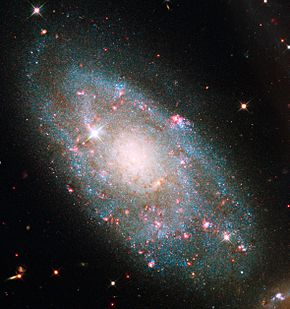| NGC 7320 | |
|---|---|
 NGC 7320 imaged by the Hubble Space Telescope | |
| Observation data (J2000.0 epoch) | |
| Constellation | Pegasus |
| Right ascension | 22h 36m 03.4s[1] |
| Declination | +33° 56′ 53″[1] |
| Redshift | 786 ± 20 km/s[1] |
| Distance | 39 million ly (12 Mpc)[2] |
| Apparent magnitude (V) | +13.2[1] |
| Characteristics | |
| Type | SA(s)d[1] |
| Apparent size (V) | 2.2′ × 1.2′[1] |
| Notable features | Foreground projection on Stephan's Quintet |
| Other designations | |
| UGC 12101, PGC 69270, Arp 319, HCG 092A[1] | |
NGC 7320 is a spiral galaxy in the constellation Pegasus. It was discovered on 27 September 1873 by French astronomer Édouard Stephan.[3]
NGC 7320 is a member of Stephan's Quintet, however, it is not an actual member of the galaxy group, but a much closer line-of-sight galaxy at a distance of about 40 million light years, the same as the nearby NGC 7331. Other galaxies of Stephan's Quintet are some 300 million light-years distant.
NGC 7320 has extensive H II regions, identified as red blobs, where active star formation is occurring.
The galaxy was imaged by the James Webb Space Telescope as part of Stephan's Quintet; the picture was released on 12 July 2022.
- ^ a b c d e f g "NASA/IPAC Extragalactic Database". Results for NGC 7320. Retrieved 2006-10-21.
- ^ Moles, M.; Marquez, I.; Sulentic, J. W. (1998). "The observational status of Stephan's Quintet". Astronomy and Astrophysics. 334: 473–481. arXiv:astro-ph/9802328. Bibcode:1998A&A...334..473M.
- ^ Seligman, Courtney. "New General Catalogue Objects: NGC 7320". Celestial Atlas. Retrieved 28 August 2024.